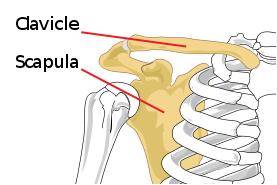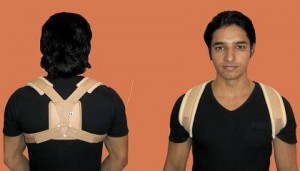Collarbone Pain – Causes and Treatment
Collarbone or clavicle (Latin clavicle = little key) is a horizontally placed bone in the upper part of the chest. This bone forms a unique link between the upper limb and the chest. It transfers the weight of the upper limb ( or any weight that is carried in our hands) to the central part of the body. Hence, any injury to the collarbone substantially weakens the carrying capacity of the hand making it virtually useless to the person.
Anatomy of Collarbone
The collarbone is attached to the breast bone (sternum) and the shoulder blade (scapula). Both the attachments are immobile joints, which are covered by strong ligaments which provide stability and support to the joints.
Picture 1: Collarbone
(source: Wikimedia)
The entire length of this bone can be easily felt at the upper part of the chest, as it lies just below the skin (subcutaneous bone). The collarbone keeps the shoulder blade in position, allowing the arm to move freely around it.
Causes of Collarbone Pain
Collarbone pain arises from injury to the bone itself, like a fracture, or injury to the supporting structures, like acromio-clavicular ligament tear. This pain is typically felt during any movement of the arm. A constant dull pain at the shoulder may also be felt even when the arm is not moving. This is mainly because of the weight of the arm on the bone. A fracture or ligament injury of the collarbone generally occurs because of a fall on the shoulder or a road accident.
The edges of the fractured (broken) bone can be easily felt or even seen in the upper part of the chest. Sometimes the jagged edges penetrate the skin causing a compound injury (fracture + open wound). The treatment of this type of injury is fairly complicated and it occurs mainly during transportation of the injured person. Hence, it is important to support the broken collarbone with a figure of 8 bandage or clavicle brace (Picture 2) before transportation to a hospital.
Picture 2: Clavicle Brace
(source: Wikimedia)
An acromio-clavicular ligament injury takes a long time to heal. Ligaments are devoid of blood supply and so their recovery may not be complete. Thus, if proper treatment is not taken this leads to lifelong disability. The person is unable to lift any weight in the affected hand. It is prudent to allow the body enough time to recover from the injury. This helps the surgeon to correctly assess the need for surgery and the type of surgery to be done.
Some of the uncommon causes of collarbone pain are bone tumors, sterno-clavicular joint dislocation (during pileups of rugby), and clavicular arthritis. Infection of clavicle can rarely cause collarbone pain along with erosion of the bone.
Treatment of Collarbone Pain
A simple collarbone fracture is treated with a figure of 8 bandage or clavicle brace (Picture 2) applied to the upper chest. The bandage or brace pulls the shoulders behind so that the entire length of the clavicle is stretched and the broken edges automatically align themselves. This allows the fracture to heal in around 4-6 weeks. It is advisable to have a repeat x-ray of the collarbone 2 weeks after the injury to ensure that the edges have not been displaced. Physical therapy is needed for the entire duration of treatment to prevent elbow stiffness and keep muscles from shrinking.
A compound collarbone fracture needs good medical care in the hands of an experienced orthopedic surgeon. The open wound is always a source of infection for the body. Hence, i.v. antibiotics have to be given for a week, followed by regular antibiotics for another couple of weeks, to prevent the spread of infection. The fracture treatment is delayed until the wound has healed and is treated like a simple collarbone fracture. Sometimes, it may be possible to fix the broken collarbone with a surgery, but this has to be delayed because of the risk of infection from the open wound near the fracture.
An acromio-clavicular ligament injury is the most difficult to treat. Mild injuries, like sprains without actual ligament tears, are treated with a sling for 2-3 weeks and gradual return to normal activity. Severe ligament injuries with completely torn acromio-clavicular ligaments are treated with a delayed surgical ligament repair. Prior to surgery the ligament tear is evaluated with an MRI to know the extent of tear and plan the required surgery. The surgery is done about 2-4 weeks after the injury. Individuals who are not involved in over the head manual work (requiring to lift the hand above the level of the head) are better off without surgery. These people can take the advantage of conservative measures like physical therapy, prolotherapy, and so on.
Complications of Collarbone Pain
An untreated fracture or ligament injury of the collarbone lead to longstanding pain at the shoulder or directly over the site of injury. Sometimes, the rough edges of fracture constantly irritate the overlying skin causing non-healing ulcers over the bone, which get infected easily.






